18 classes of important drugs acting on receptors
by egpat 07-10-2017
Chemical mediators play a vital role in producing cellular effects by acting on the target cells. Many of these mediators act through their corresponding receptors to produce cellular effects. Mediators like acetylcholine, norepinephrine, serotonin, dopamine and histamine all belongs to this category. Hormones like estrogen, progestogens and corticosteroids all act on their respective receptors. On the other hand, few of the mediators like nitric oxide directly activate enzymes to produce cellular effects without acting on any receptor.
As most of the mediators act through receptors, the later act as potential drug targets for many of the clinically important drugs. Here we will discuss these important drug targets acting on receptors.
Nicotinic acetylcholine receptors
Nicotinic acetylcholine receptors are present at adrenal medulla, autonomic ganglia, neuromuscular junction and widely in the CNS. All these locations may not act as good drug targets due to wide coverage of the functionality of these receptors.
For example, drugs blocking autonomic ganglia produce mixed effects due to block of both sympathetic and parasympathetic ganglia. Hence these drugs have little clinical uses.
Similarly till now no good drug target is available to act specifically on nicotinic receptors within the CNS as the role of acetylcholine within the CNS is more complex and controlled by other mediators.
Neuromuscular blockers
So, only one of the locations where successful drug targets available is neuromuscular junction. Two types of categories such as depolarising and non-depolarising neuromuscular blockers act on nicotinic acetylcholine receptors at neuromuscular junction and produce muscle relaxation.
These drugs include
- Depolarising neuromuscular blocker
- Suxamethonium
- Non-depolarising neuromuscular blockers
- d-Tubocurarine
- Gallamine
- Pancuronium
- Vecuronium
- Rocuronium
- Atracurium
- Cisatracurium
- Mivacurium
Even both these drugs act at same target and produce similar effect, a little difference exists between these two. Depolarising blockers act as agonist and produce persistent depolarisation leading to relaxation whereas non-depolarising blockers act as antagonist and directly produce relaxation.
They also show difference in their side effect profile. Even though these drugs specifically act on nicotinic receptors, they also show a little affinity towards muscarinic receptors. Depolarising neuromuscular blockers produce bradycardia whereas non-depolarising neuromuscular blockers produce tachycardia again due to agonist and antagonist activity on muscarinic receptors.
Muscarinic acetylcholine receptors
Majority of the actions of acetylcholine are mediated through muscarinic receptors. Muscarinic receptors are present at various locations like heart, smooth muscle, glands and also in CNS.
Muscarinic agonists
Drugs like carbachol, bethanechol and pilocarpine act as agonist on these receptors.

Pilocarpine and carbachol are used in the treatment of glaucoma whereas bethanichol is used for urinary retention associated with hypotonic bladder.
Muscarinic antagonists
A number of drugs, commonly called as anticholinergics, act as muscarinic antagonists and clinically very useful. These drugs include

Few of the drugs selecively block muscarinic receptors. Pirenzepine acts on M1, gallamine on M2 and darifenacin on M3 receptors.
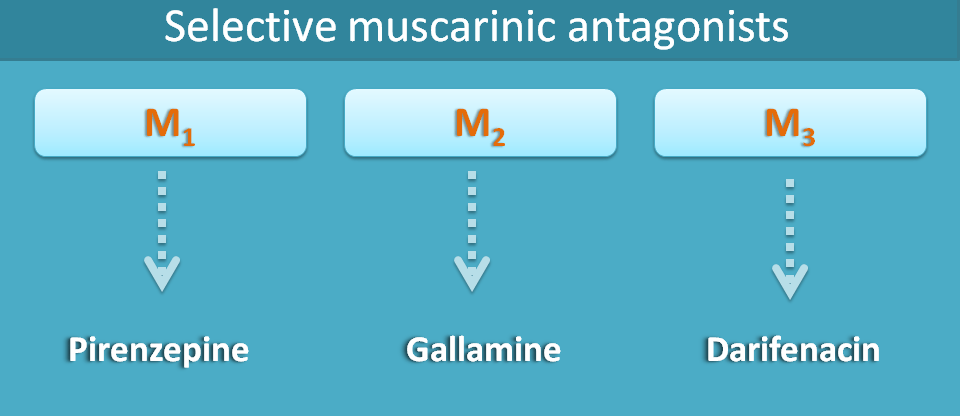
As M1 receptors are responsible for gastric acid secretion, M1 blocker like pirenzepine acts as antiulcer agent. Similarly M3 blocker like darifenacin acts as bladder relaxant.
Gallamine acts both as M2 blocker as well as neuromuscular blocker and nowadays little used due to tachycardia as its side effect.
In addition to the above drugs, many of other category agents like antihistamines and tricyclic antidepressants also block these muscarinic receptors.
α adrenergic receptors
alpha receptors are of two types α1 and α2. Former are mainly present on smooth muscle and later at presynaptic nerve terminals.
Alpha agonists
α1 agonists like oxymetazoline and xylometazoline act on nasal vascular smooth muscle and produce constriction. Hence they are used ass nasal decongestants.
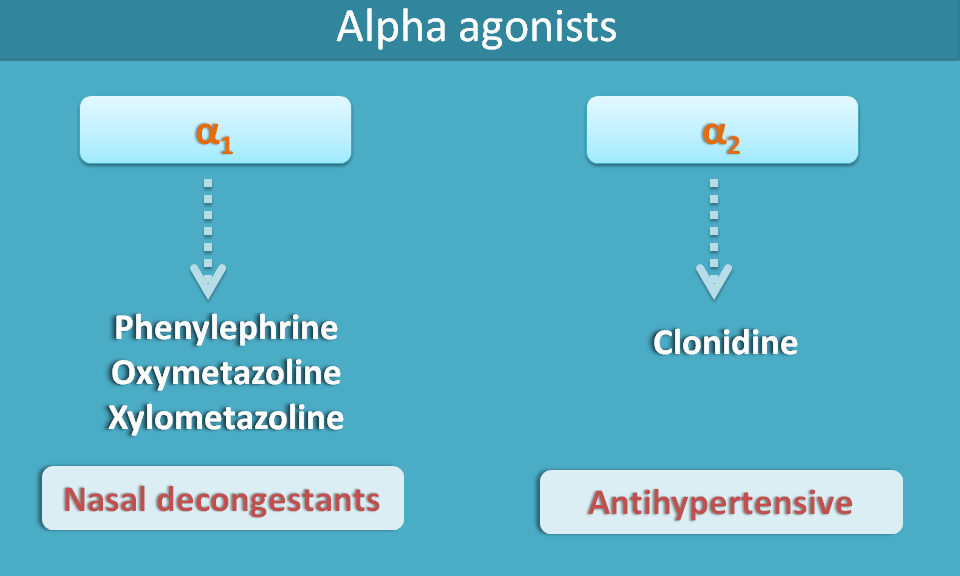
Similarly α2 agonists like clonidine acts on autoinhibitory presynaptic receptors and decreases central sympathetic discharge. Hence it can be used as centrally acting antihypertensive.
Alpha blockers
Non-selective alpha blockers like phenoxybenzamine and phentolamine act on both α1 and α2 receptors and mainly produce vasodilatation.
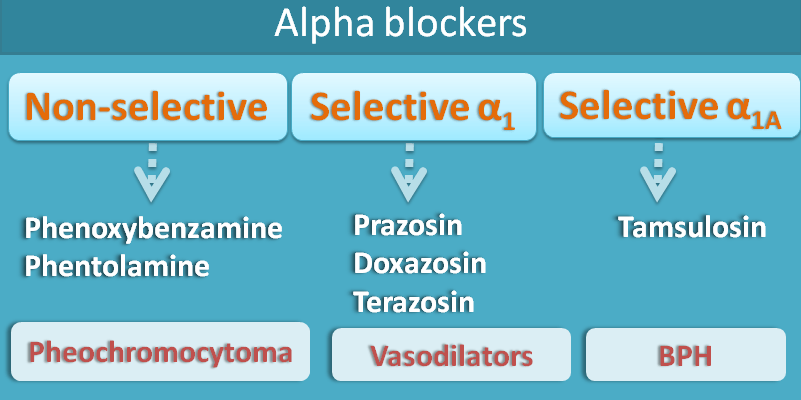
They can be used in management of pheochromocytoma to block the action of catechol amines on alpha receptors.
Selective α1 blockers include
- Prazosn
- Doxazosin
- Terazosin
- Alfuzosin
All these drugs can be used as direct vasodilators in the treatment of hypertension. Alfuzosin is selective on bladder.
Tamsulosin is selective α1A antagonist specifically acts on bladder and prostate tissue hence used in benign prostatic hypertrophy.
β adrenergic receptors
Beta agonists
β1 receptors are mainly located on cardiac muscle and drugs like dobutamine increase both rate and force of contraction of the heart therefore indicated as cardiotonics in heart failure.

β2 receptors agonists like terbutaline, salbutamol, salmeterol and formoterol specifically act on bronchial smooth muscle and produce bronchodilatation indicated for asthma.
Beta blockers
Non-selective beta blockers like propranolol, nadolol and timolol are used as general sympatholytics in various conditions like cardiac arrhythmias, angina, hypertension and anxiety disorders.
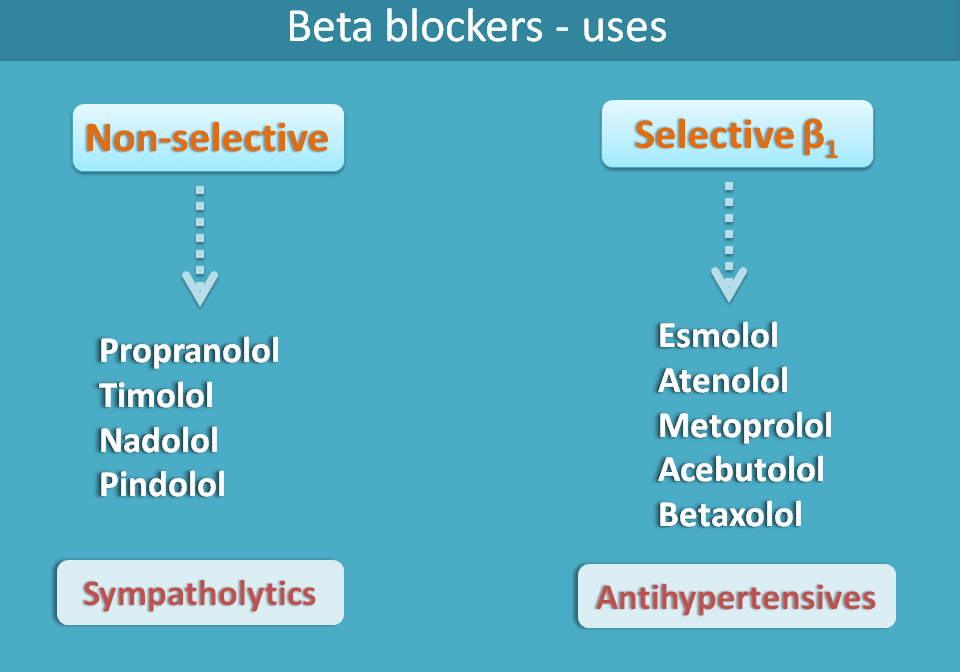
Selective beta blockers include esmolol, metoprolol, atenolol, acebutolol etc.
For complete details on beta blockers, visit central role of beta blockers in cardiac disorders.
Dopamine receptors
Dopamine is one of the important meditators within the CNS where it acts through varius dopamine receptors ranging from D 1 to D5.
Fenoldapam is an antihypertensive used in emergenecy treatment that acts on dopamine receptors at nephron leading to renal vasodilatation. This improves rate of excretion hence decreasing body volume and blood pressure.
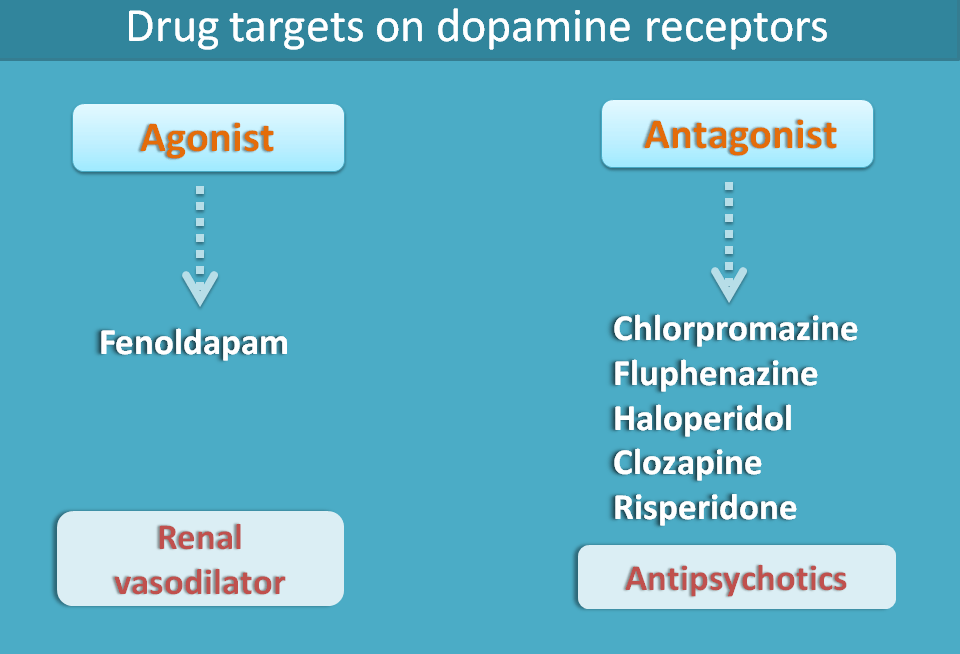
Antipsychotic drugs like phenothiazines, butyrophenones and atypical antipsychotics all block dopamine receptors at nigrostriatal pathway improving the symptoms of schizophrenia.
Serotonin receptors
Serotonin is one of the mediators that has variety of roles both in peripheral and central levels. It acts through 5-HT1 to 5-HT7 receptors which are further subdivided.
Among these 5-HT1 receptors are autoinhibitory i.e. they decrease the release of 5-HT.
5-HT1A agonists
Buspirone is a 5-HT1A agonist that decreases anxiety without producing any motor disturbances as benzodiazepines do. Hence it is used as anxiolytic but it can’t be used for acute conditions due to its delayed actions observed after 2-4 weeks of treatment.

5-HT1D agonists
Triptan drugs like sumatriptan, rizatriptan, almotriptan and eletriptan act on 5-HT1D receptors as agonists and indicated for migraine.
5-HT2A antagonists
Similarly 5-HT2A antagonists like ergotamine, cyproheptadine and ketanserin are used in the treatment of migraine.
5-HT3 antagonists
Drugs like ondansetron, granisetron and tropisetron act on 5-HT3 receptor as antagonists and indicated as antiemetics.
5-HT4 agonists
5-HT4 receptors are mainly located on gastric smooth muscle controlling peristalsis. Drugs like metoclopramide and domperidone act on these receptors as agonists and increase the GI motility hence called as prokinetic drugs . Again they are indicated as entiemetics.
Histamine receptors
Histamine acts as local mediator released from mast cells and chromaffin cells and acts locally on histamine receptors. Histamine actions mediated by H1 receptors are responsible for allergic and anti-inflammatory actions whereas those actions through H2 receptors are responsible for gastric acid release.
H1 antagonists
Therefore first generation H1 antagonists like chlorpheniramine, diphenhydramine, cyclizine, promethazine and second generation antihistamines like cetirizine, fexofenadine and loratidine are indicated for various conditions like allergic rhinitis, hay fever, urticaria etc.
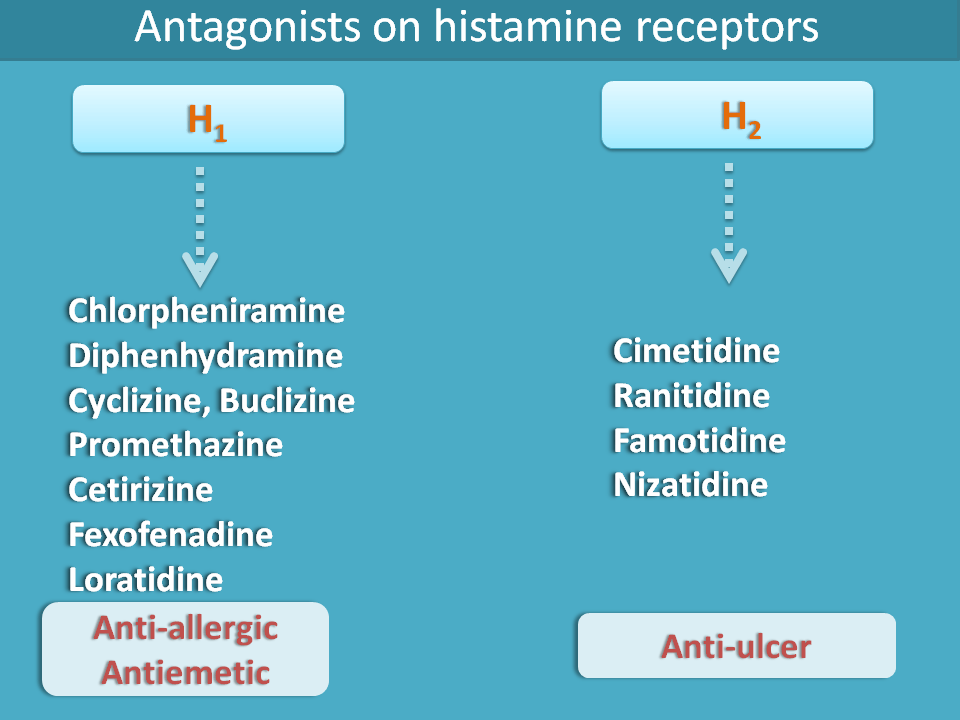
Second generating antihistamines are less sedative than first generation drugs.
H2 antagonsits
On the other hand, H2 antagonists like cmetidine, ranitidine, famotidine and nizatidine are used as antiulcer agents.
AT II receptors
Angiotensin II is a potent vasoconstrictor increasing blood pressure and also increases aldosterone secretion enhancing sodium and water reabsorption.

Therefore AT II receptor blockers commonly called as “sartan” drugs such as losartan, valsartan, olemsartan and telmisartan play an important role as vasodilators in the treatment of hypertension.
Bradykinin receptors
Bradykinin is a vasodilator that opens potassium channels leading to hyperpolarisation on vascular smooth muscle. Due to its vasodilatory effects it increases tissue perfusion thereby increases swelling and angioedema.
Icatibant is a bradykinin receptor antagonists that inhibits the actions of the bradykinin and hence indicated for hereditary angioedema.
Leukotriene receptors
Cystinyl Leukotrienes are one of the broncho constrictory mediators that are derived from phospholipids through lipoxygnase pathway.
Their antagonists like motelukast and zafirlukast hence used as anti-allergic agents in the treatment of asthma and rhinitis.
Ryanodine receptors
Ryanodine receptors regulate the release of intracellular calcium from sarcoplasmic reticulum. When these receptors are persistently stimulated by drugs such as suxamethonium, they release excess calcium resulting in repeated contractions and raise in body temperature leading to malignant hyperthermia.
This condition can be treated by dantrolene, a ryanodine receptor antagonist, that decreases calcium release from sarcoplasmic reticulum.
Vanilloid receptors
Vanilloid receptors are responsible opening of sodium channels and depolarisation of nociceptive nerve endings producing pain transmiision.
Capsaicin is one of the drug derived from red capsicum binds to these receptors and prevents action of substance P decreasing pain transmission.
Prostaglandin receptors
Again prostaglandins are another type of local mediators producing a varety of actions through their receptors.
Prostaglandin E receptors
Misoprostol is a prostaglandin E analogue that acts on EP receptors thereby increases uterine contractions. Hence it can be used in medical termination of pregnancy.

It also decreases gastric acid secretion and can be used in NSAID induced ulcers.
Prostaglandin I receptors
Epoprostenol is a PG I analogue that inhibits platelet aggregation thereby prevents thrombue formation. I can be used cardiovascular disorders as preventive medication.
Prostgalndin F receptors
Latanoprost is PG F analogue that decreases intraocular tension in the eye. Hence it can be used in open angle glaucoma.
Aldosterone receptors
Aldosterone antagonists like spironolactone and eplerenone block the actions of aldosterone thereby decrease sodium absorption and increase its excretion. As the sodium is excreted potassium is retained within the body hence these drugs are called as potassium sparing diuretics.
They particularly used in the treatment of heart failure and hyperaldosteronism.
Estrogen receptors
Ethinyl estradiol and megestrol are estrogen agonists used for hormonal replacement therapy. They can also be combined wih progestogens as oral contraceptives.

Tamoxifen, raloxifene and clomiphene are selective estrogen receptor modulators that antagonise few actions of estrogens at the same time increasing other actions.
For example, raloxifene antagonises the action of estrogen on breast tissue but increases its action on bones preventing osteoporosis.
Tamoxifen mainly shows antagonistic actions hence indicated in breast cancer.
Clomiphene increase the estrogen action of ovulation hence used for patients with decreased ovulation.
Progestogen receptors
Progestogens mainly have two clinical indications. One, as components of hormonal replacement therapy and another as oral contraceptives.
Drugs like norethindrone, norgestimate, norgestrel and desogestrel are used as oral contraceptives. Medroxyprogesterone is used as IV contraceptive
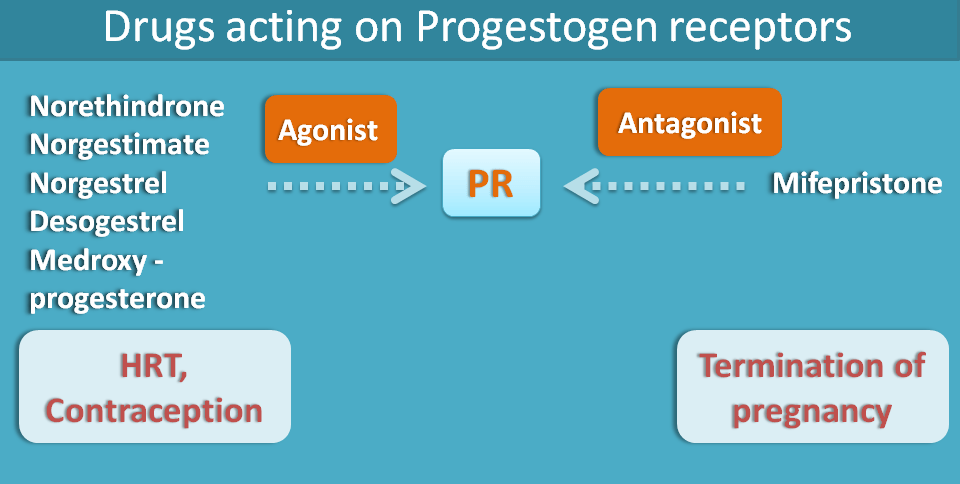
Similarly antiprogestins like mifepristone is used for termination of pregnancy.
Androgen receptors
Testosterone acts as androgen receptor agonist and used for development of secondary sexual characters in males.
Cyproterone and flutamide are androgen receptor antagonists that inhibit the action of testosterone in prostate cancer.
Coricosteroid receptors
Corticosteroids particularly glucocorticoids play a significan role as anti-inflammatory agents and immunosuppresants.
Prednisone, prednisolone,hydrocortisone, betamethasone and dexamethasone act as anti-inflammatory agents.

New generation corticosteroids like mometasone, ciclesonide, budesonide and fluticasone have less systemic absorption and hence less systemic sude effects. They can used as preventive medication in the treatment of asthma.
So these are the few of the important drug targets acting on various receptors. If you like this post, please don't forget to share it with your friends.